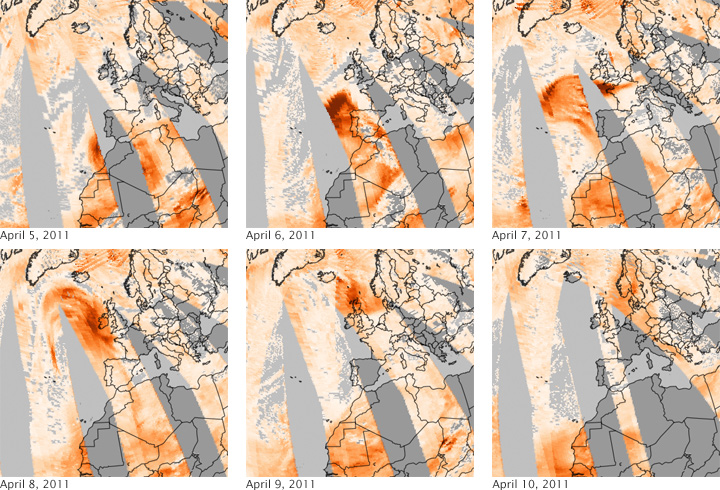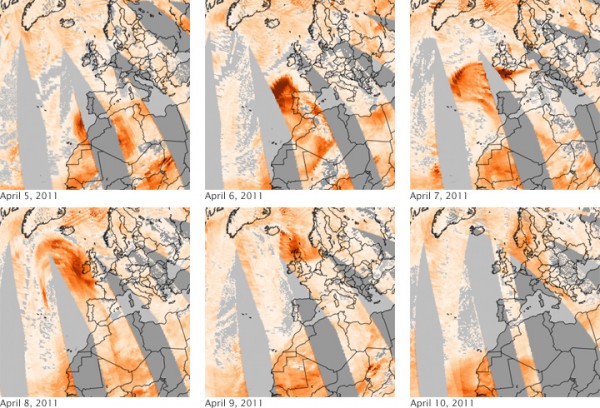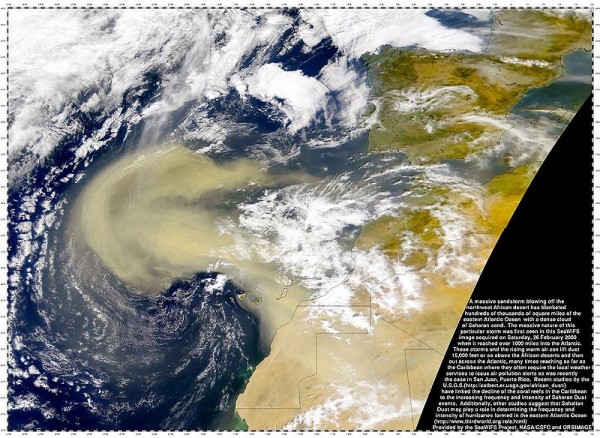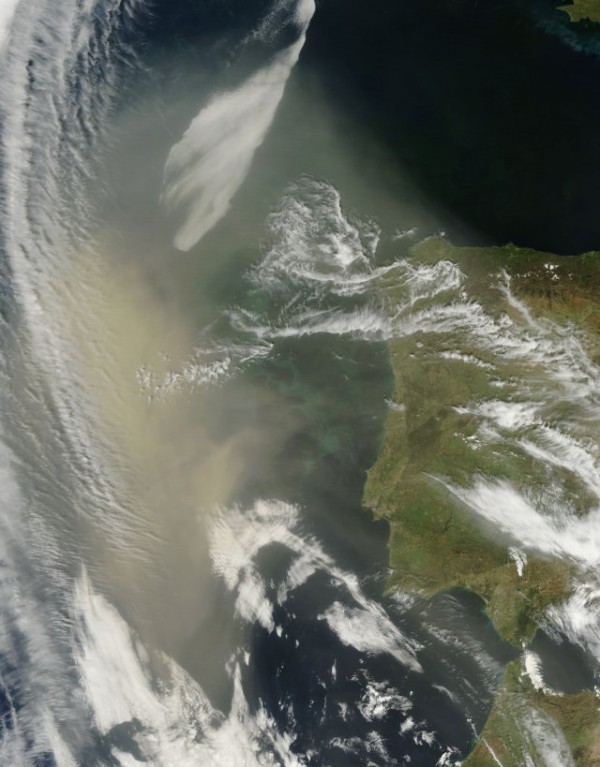Dust blew from Africa to Scandinavia

Atmospheric scientists track aerosols—tiny solid and liquid particles suspended in our atmosphere—because they have important impacts on weather, climate, and human health. Mineral dust is one of the most abundant aerosols, a product of winds blowing across our deserts and beaches, picking up tiny bits of rock and sand and distributing them all over the world. Dust can fertilize the ocean for plankton and seed the sky for cloud formation.
Sometimes dust storms are just cool to watch, as well. In this series of images from the Ozone Monitoring Instrument (OMI) on NASA’s Aura satellite, the dust from a Saharan sand storm blows several thousand kilometers over the North Atlantic and Europe in April 2011. Aerosol concentrations in the air are represented by a quantity known as the aerosol index, with the highest concentrations in deep red and the lowest in light yellow. The gray areas represent clouds or areas where no reliable OMI data were available.
The aerosol index is calculated based on how particles absorb and scatter light. Specifically, the index is a measurement of the difference between the amount of ultraviolet (UV) light the dust-filled atmosphere scatters back to the satellite compared to the amount of UV the atmosphere would scatter back if skies were totally clear.
OMI spied the Saharan dust on April 5, 2011, as it was blowing over Morocco and Algeria (top left image). By the next day (top middle), the plume drifted north past the coast of Portugal; the Moderate Resolution Imaging Spectroradiometer (MODIS) on NASA’s Terra satellite captured this natural-color view of the event, as well. The storm veers west, then north and east on April 7 –9, before arriving over Scandinavia on April 10 (bottom right).
Though Saharan dust blows through Europe several times a year, “the scale of this cloud and the amount of dust is somewhat unusual, including the amount of dust transported to the northern and eastern parts of Europe,” said atmospheric scientist Colin Seftor, based at NASA’s Goddard Space Flight Center. “I’ve seen events of this magnitude maybe once every couple of years.”
“Dust clouds can travel long distances under the right conditions,” Seftor added. “The typical pathway for the transport of Saharan dust clouds is westward, all the way across the Atlantic to the Americas. In fact, Miami often suffers from poor air quality due to this dust. And we’ve tracked dust clouds from the Gobi desert being transported all the way across the Pacific as far the East Coast of the United States.”
The GEOS-5 atmospheric model from NASA Goddard pretty accurately forecast the trajectory and evolution of the storm between April 4 and April 9. Click here for an animation (9 megabytes) of the model prediction. (Earth Observatory)
The Sahara is the major source on Earth of mineral dust (60-200 millions of tons per year). Saharan dust can be lifted by convection over hot desert areas, and can thus reach very high altitudes; from there it can be transported worldwide by winds, covering distances of thousands of kilometers. The dust combined with the hot dry air of the Sahara Desert often forms an atmospheric layer called the Saharan Air Layer which has significant effects on tropical weather, especially as it interferes with the development of hurricanes.
There is a large variability in the dust transport across the Atlantic into the Caribbean and Florida from year to year. Due to the trade winds, very large concentrations of mineral dust can be found in the tropical Atlantic, reaching the Caribbean; moreover episodic transport to the Mediterranean region as well as Northern Europe is observed. In the Mediterranean region, Saharan dust is important as it represents the major source of nutrients for phytoplankton and other aquatic organisms. Saharan dust carries the fungus Aspergillus sydowii and others. Aspergillus borne by Saharan dust falls into the Caribbean Sea and possibly infects coral reefs with Sea Fan disease (aspergillosis). It also has been linked to increased incidence of pediatric asthma attacks in the Caribbean. Since 1970, dust outbreaks have worsened due to periods of drought in Africa. Dust events have been linked to a decline in the health of coral reefs across the Caribbean and Florida, primarily since the 1970s.
For an alternate view, the Terra satellite captured this true colour image of the plume passing Portugal:




Commenting rules and guidelines
We value the thoughts and opinions of our readers and welcome healthy discussions on our website. In order to maintain a respectful and positive community, we ask that all commenters follow these rules:
We reserve the right to remove any comments that violate these rules. By commenting on our website, you agree to abide by these guidelines. Thank you for helping to create a positive and welcoming environment for all.